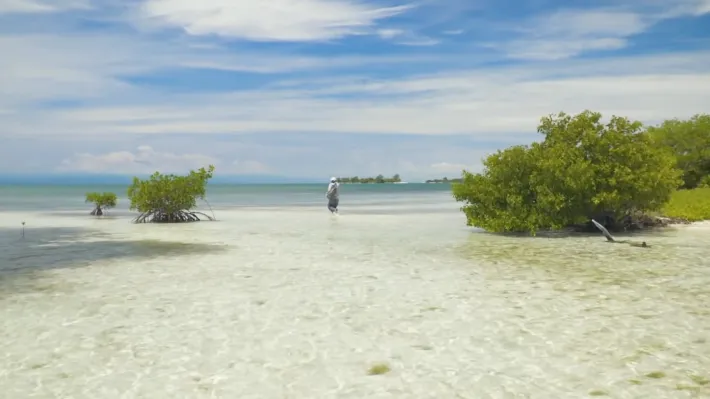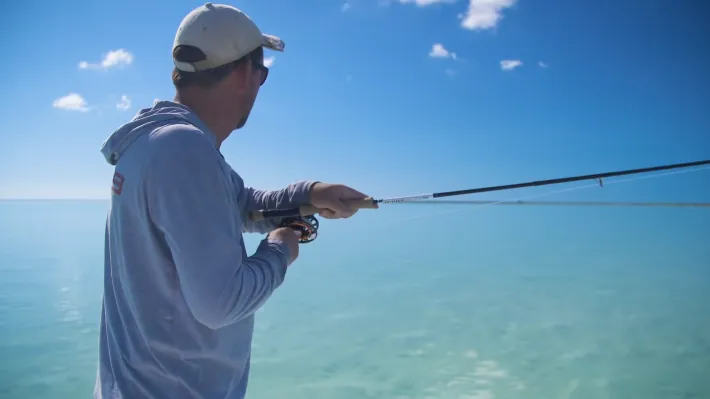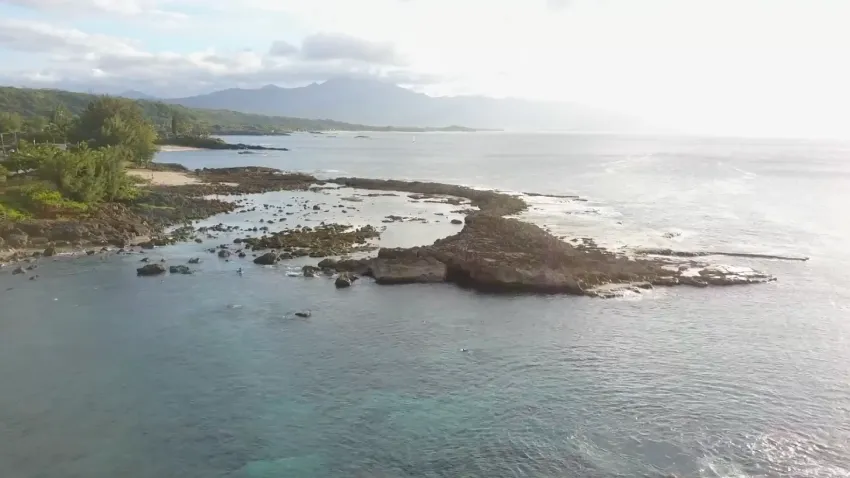Key Takeaways:
- Several fly fishing opportunities exist in Hawaii, both freshwater and saltwater, so it’s an ideal destination for anglers.
- The winter months (November to April) and the summer months (May to October) are the best seasons for fly fishing there.
- Fly anglers have plenty of options in Hawaii’s fly fishing spots, including Ulua Barracuda, Hawaiian Bonefish, Awa-awa Ladyfish, and many more.
- The Division of Aquatic Resources (DAR) regulates fly fishing in Hawaii, with specific rules for licenses and permits, regulated species, and gear restrictions.
- The stunning natural scenery of Hawaii, combined with its abundance of fishing opportunities, makes it a unique and unforgettable fly fishing destination.
9 Popular Fly Fishing Spots in Hawaii

The pristine waters and abundance of fish species in Hawaii make it an ideal destination for fly fishing enthusiasts. The following are the top 9 fly fishing locations in this US state that offer unforgettable fishing experiences.
- Lake Wilson
- Kokee State Park
- Kiholo Bay
- Kona Coast State Park
- Puako Reefs
- Koaie Stream
- Honokohau Harbor
- Spencer’s Beach State Park
- Kawaihae Area
Now, check out each of Hawaii’s top 9 fly fishing spots, where angling enthusiasts can experience the perfect blend of natural beauty and the thrill of fly fishing.
1. Lake Wilson
- Nestled in the central part of Oahu, Lake Wilson is a serene freshwater reservoir.
- Known for its diversity, you can target smallmouth bass, largemouth bass, peacock bass, tilapia, and channel catfish.
- For the best success in fly fishing, consider visiting between April and October, when the conditions are optimal and the fish are most active.
2. Kokee State Park
- Situated in the scenic northwest of Kaua’i, Kokee State Park extends for 24 km in the Hawaiian Islands.
- The specialty here is the seasonal rainbow trout fishing, which runs from June 17 to September 30, creating a brief but intense fishing season.
- To get the most out of fly fishing, consider using Elk Hair Caddis and Bead Head Nymphs.
3. Kiholo Bay
- Situated in the North Kona District on the Big Island of Hawaii, it spans approximately 2 miles in length (3.2 km).
- Known for its saltwater fly fishing opportunities, targeting species like trevally, barracuda, and bonefish in the stunning bay.
- For successful saltwater fly fishing at Kiholo Bay, consider using fly patterns like Crazy Charlie and Clouser Minnow.
4. Kona Coast State Park
- Located along the north Kona coast on the island of Hawai’i, Kekaha Kai State Park.
- Ideal for shore-casting, offering opportunities to catch species like grouper, trevally, and goatfish.
- Recommended fly patterns for this location include Deceiver flies and Clouser Minnows.
5. Puako Reefs
- A fisheries management area, situated near Puakō Point on the Big Island of Hawaii.
- Suitable for skilled anglers targeting bonefish using saltwater flies like Lefty’s Deceiver and Crazy Charlie.
- When fly fishing at Puako Reefs, be prepared for the diverse conditions, including reef flats and tide pools, which offer a unique fishing experience.
6. Koaie Stream
- Located in the Alakai swamp on the island of Kauai, Koaie Stream offers pristine fly fishing opportunities in Kauai County, Hawaii.
- Known for hosting some of the best rainbow trout fishing in the USA, this location requires a challenging 4 to 6-hour hike through beautiful but tough terrain.
- When planning to fly fish in the Koaie Stream, equip yourself with Beadhead Nymphs and black Woolly Buggers with a brass head.
7. Honokohau Harbor
- A marina in Kailua-Kona, Hawaii, conveniently located between Kona Airport and Kailua-Kona town.
- This harbor offers excellent shore-casting opportunities, where anglers can catch giant trevallies and queenfish.
- Pay attention to the tides and currents, especially around the harbor entrance. It is best to fish during high tides or changing tides.
8. Spencer’s Beach State Park
- Situated on Kokololio Beach Road, about 45 miles north of Kailua-Kona.
- This location offers opportunities to catch Wahoo, Sailfish, and Yellowtail, though it may require some effort to access.
- The journey to Spencer Beach Park is well worth it for those keen on targeting pelagic species.
9. Kawaihae Area
- Located 35 miles (56 km) north of Kailua-Kona on the west side of the island of Hawai’i.
- The proximity to Kailua-Kona and the variety of pelagic species make Kawaihae an attractive destination for those seeking a wide range of fishing experiences.
- Opt for live bait or trolling techniques for the best chance of landing great catches.
What is the ideal season for engaging in a fly fishing adventure in Hawaii?
During Hawaii’s two main seasons, fly fishing is best: winter (November to April) and summer (May to October). These periods offer optimal conditions for fly fishing, with various fish species becoming active and more accessible.
Lake Wilson on Oahu is a great spot for fly fishing year-round, while Kokee State Park on Kauai is best for rainbow trout from June 17 to September 30. For those targeting trevally, barracuda, and bonefish, Kiholo Bay on the Big Island is accessible year-round.
Hawaii’s pleasant climate ensures that you can enjoy freshwater or saltwater fly fishing any time of year. So, if you’re planning a fly fishing adventure in Hawaii, visit during the winter or summer season, depending on your target fish species, for an unforgettable experience.
Which fish species are typically caught in Hawaii using fly fishing techniques?

In Hawaii, you will have the opportunity to target a variety of fish species. Among the popular species to catch using fly fishing techniques in Hawaii are Ulua Barracuda (Kaku), found in Honokohau Harbor and Kona Coast State Park.
You can also catch Hawaiian Bonefish (O’io), typically found at Kiholo Bay, and Awa-awa Ladyfish, which can also be caught at Kiholo Bay.
Additionally, other notable species you might encounter on your fly fishing adventure include Spotted Roi, Aha giant needlefish, Hawkfish, Trumpetfish, Boxfish, Goatfish, and Peacock flounder.
What are Hawaii’s regulations for fly fishing?
Fly fishing regulations in Hawaii are mostly regulated by the Division of Aquatic Resources (DAR), part of the Hawaii Department of Land and Natural Resources (DLNR). Here are some fly fishing rules you need to know:
Licenses & Permits: In Hawaii, residents are generally not required to obtain a marine recreational fishing license. But remember that a Freshwater Game Fishing License is needed for specific freshwater fishes, especially for introduced game species.
Regulated Species: Hawaii’s fishing regulations encompass a diverse array of marine species, such as Ahi, Aholehole, ‘Ama‘ama, Awa, Moi, Uhu, Ulua, Kumu, Moano, and more.
Each species is subject to specific regulations that define minimum size limits, closed seasons, and bag limits.
Gear Restrictions: Hawaii has specific gear restrictions for various fishing methods, including minimum mesh size requirements for throw nets, gill nets, and other types of nets.
For example, throw nets must have a minimum mesh size of 2 inches when stretched, and it’s illegal to possess throw nets with mesh sizes less than 2 inches near fishable waters.
Gill nets, draw nets, drag nets, and seines generally require a 2-inch mesh when stretched, with restrictions on leaving them unattended.
There are exceptions for using hand nets or scoop nets with smaller mesh sizes for noncommercial purposes, provided they don’t exceed three feet in any dimension.These gear restrictions promote sustainable fishing and protect marine life. You must know and adhere to these regulations while fly fishing in Hawaii.

